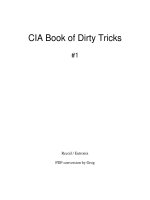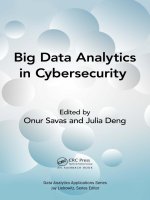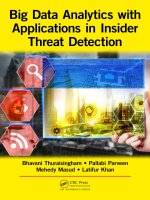Hacking ebook dataanalyticsforinternalauditors
Bạn đang xem bản rút gọn của tài liệu. Xem và tải ngay bản đầy đủ của tài liệu tại đây (6.93 MB, 441 trang )
Data Analytics
for Internal Auditors
Internal Audit and IT Audit
Series Editor: Dan Swanson
Cognitive Hack: The New Battleground in
Cybersecurity ... the Human Mind
James Bone
ISBN 978-1-4987-4981-7
The Complete Guide to Cybersecurity
Risks and Controls
Anne Kohnke, Dan Shoemaker,
and Ken E. Sigler
ISBN 978-1-4987-4054-8
Corporate Defense and the Value
Preservation Imperative:
Bulletproof Your Corporate
Defense Program
Sean Lyons
ISBN 978-1-4987-4228-3
Data Analytics for Internal Auditors
Richard E. Cascarino
ISBN 978-1-4987-3714-2
Ethics and the Internal Auditor’s
Political Dilemma:
Tools and Techniques to Evaluate
a Company’s Ethical Culture
Lynn Fountain
ISBN 978-1-4987-6780-4
A Guide to the National Initiative
for Cybersecurity Education (NICE)
Cybersecurity Workforce
Framework (2.0)
Dan Shoemaker, Anne Kohnke,
and Ken Sigler
ISBN 978-1-4987-3996-2
Implementing Cybersecurity:
A Guide to the National Institute
of Standards and Technology Risk
Management Framework
Anne Kohnke, Ken Sigler, and Dan Shoemaker
ISBN 978-1-4987-8514-3
Internal Audit Practice from A to Z
Patrick Onwura Nzechukwu
ISBN 978-1-4987-4205-4
Leading the Internal Audit Function
Lynn Fountain
ISBN 978-1-4987-3042-6
Mastering the Five Tiers
of Audit Competency:
The Essence of Effective Auditing
Ann Butera
ISBN 978-1-4987-3849-1
Operational Assessment of IT
Steve Katzman
ISBN 978-1-4987-3768-5
Operational Auditing:
Principles and Techniques for
a Changing World
Hernan Murdock
ISBN 978-1-4987-4639-7
Practitioner’s Guide to Business Impact
Analysis
Priti Sikdar
ISBN 978-1-4987-5066-0
Securing an IT Organization through
Governance, Risk Management,
and Audit
Ken E. Sigler and James L. Rainey, III
ISBN 978-1-4987-3731-9
Security and Auditing of Smart Devices:
Managing Proliferation of Confidential Data
on Corporate and BYOD Devices
Sajay Rai, Philip Chukwuma,
and Richard Cozart
ISBN 978-1-4987-3883-5
Software Quality Assurance:
Integrating Testing, Security, and Audit
Abu Sayed Mahfuz
ISBN 978-1-4987-3553-7
Data Analytics
for Internal Auditors
Richard E. Cascarino
CRC Press
Taylor & Francis Group
6000 Broken Sound Parkway NW, Suite 300
Boca Raton, FL 33487-2742
© 2017 by Taylor & Francis Group, LLC
CRC Press is an imprint of Taylor & Francis Group, an Informa business
No claim to original U.S. Government works
Printed on acid-free paper
Version Date: 20161122
International Standard Book Number-13: 978-1-4987-3714-2 (Hardback)
This book contains information obtained from authentic and highly regarded sources. Reasonable efforts
have been made to publish reliable data and information, but the author and publisher cannot assume
responsibility for the validity of all materials or the consequences of their use. The authors and publishers
have attempted to trace the copyright holders of all material reproduced in this publication and apologize to copyright holders if permission to publish in this form has not been obtained. If any copyright
material has not been acknowledged please write and let us know so we may rectify in any future reprint.
Except as permitted under U.S. Copyright Law, no part of this book may be reprinted, reproduced, transmitted, or utilized in any form by any electronic, mechanical, or other means, now known or hereafter invented, including photocopying, microfilming, and recording, or in any information storage or
retrieval system, without written permission from the publishers.
For permission to photocopy or use material electronically from this work, please access www.copyright
.com ( or contact the Copyright Clearance Center, Inc. (CCC), 222 Rosewood
Drive, Danvers, MA 01923, 978-750-8400. CCC is a not-for-profit organization that provides licenses and
registration for a variety of users. For organizations that have been granted a photocopy license by the
CCC, a separate system of payment has been arranged.
Trademark Notice: Product or corporate names may be trademarks or registered trademarks, and are
used only for identification and explanation without intent to infringe.
Visit the Taylor & Francis Web site at
and the CRC Press Web site at
Contents
About
the
A u t h o r xiii
I n t r o d u c t i o n xv
t o D ata A n a ly s i s 1
Benefits to Audit
2
Data Classification
5
Audit Analytical Techniques
7
Data Modeling
7
Data Input Validation
8
Getting the Right Data for Analysis
9
Statistics11
C h a p t e r 1 I n t r o d u c t i o n
C h a p t e r 2U n d e r s ta n d i n g S a m p l i n g 15
Population Sampling
Sampling Risk
General Advantages
Planning the Audit
Data Analysis Objectives
Characteristics of Populations
Population Variability and Probability Distributions
Binomial Distributions
Poisson Distribution
Continuous Probability Distributions
Normal Distribution
Uniform Distributions
Exponential Distribution
Central Tendency and Skewed Distributions
Population Characteristics
15
17
20
20
21
21
22
22
23
24
24
25
26
26
27
v
vi
C o n t en t s
C h a p t e r 3 J u d g m e n ta l
versus
S tat i s t i c a l S a m p l i n g 29
Judgmental Sampling
The Statistical Approach
Sampling Methods
Calculation of Sample Sizes
Attribute Sampling Formula
Classic Variable Sampling Formula
PPS Sampling Formula
Selecting the Sample
Interpreting the Results
Nonparametric Testing
Confusing Judgmental and Statistical Sampling
Common Statistical Errors
C h a p t e r 4P r o b a b i l i t y Th e o r y
in
Probability Definitions
Classical Probability
Empirical Probability
Subjective Probability
Probability Multiplication
Conditional Probability
Bayes’ Theorem
Use in Audit Risk Evaluation
Other Uses
Financial Auditing
Overstatement of Assets
Probability Distributions
29
31
31
36
36
38
38
40
41
42
43
43
D ata A n a ly s i s 45
45
46
47
48
48
48
50
51
52
52
53
53
o f E v i d e n c e 55
Influencing Factors
55
Quantity Required
57
Reliability of Evidence
57
Relevance of Evidence
58
Management Assertions
58
Audit Procedures
59
Documenting the Audit Evidence
60
Working Papers
60
Working Paper Types
60
Contents of Permanent File
62
Contents of Current File
63
Selection63
Client Background
63
Internal Control Descriptions
64
Audit Program
64
Results of Audit Tests
64
Audit Comment Worksheets
65
Report Planning Worksheets
65
Copy of the Audit Report
65
C h a p t e r 5Ty p e s
C o n t en t s
vii
Follow-Up Program
65
Follow-Up of Prior Audit Findings
66
Audit Evaluation
66
Ongoing Concerns
66
Administrative/Correspondence66
General Standards of Completion
66
Cross-Referencing66
Tick Marks
67
Notes68
Working Paper Review
68
General Review Considerations
69
Working Paper Retention/Security
70
C h a p t e r 6P o p u l at i o n A n a ly s i s 71
Types of Data
71
Correspondence Analysis
72
Factor Analysis
72
Populations74
Sampling Error
75
Central Tendency
76
Variation77
Shape of Curve
80
C h a p t e r 7C o r r e l at i o n s , R e g r e s s i o n s , a n d O t h e r
A n a ly s e s 83
Quantitative Methods
Trend Analysis
Chi-Squared Tests
Correspondence Analysis
Cluster Analysis
Graphical Analysis
Correlation Analysis
Audit Use of Correlation Analysis
Learning Curves
Ratio and Regression Analysis
The Least Squares Regression Line
Audit Use of Regression Analysis
Linear Programming
Parametric Assumptions
Nonparametric Measurement
Kruskal-Wallis Analysis of Variance (ANOVA) Testing
C h a p t e r 8C o n d u c t i n g
the
83
83
85
86
86
88
88
90
91
92
93
94
94
96
96
96
A u d i t 99
Audit Planning
Risk Analysis
Determining Audit Objectives
Compliance Audits
Environmental Audits
99
100
104
105
106
viii
C o n t en t s
Financial Audits
Performance and Operational Audits
Fraud Audits
Forensic Auditing
Quality Audits
Program Results Audits
IT Audits
Audits of Significant Balances and Classes of Transactions
Accounts Payable Audits
Accounts Receivable Audits
Payroll Audits
Banking Treasury Audits
Corporate Treasury Audits
106
107
107
108
110
110
111
112
114
115
116
116
117
C h a p t e r 9O b tai n i n g I n f o r m at i o n f r o m IT S y s t e m s
f o r A n a ly s i s 119
Data Representation
119
Binary and Hexadecimal Data
119
Binary System
119
Hexadecimal System
119
ASCII and EBCDIC
120
Fixed-Length Data
120
Delimited Data
121
Variable-Length Data
121
Databases121
Definition of Terms
122
Principals of Data Structures
123
Database Structuring Approaches
123
Sequential or Flat File Approach
123
Hierarchical Approach
124
Network Approach
124
Relational Model
125
Data Manipulation
125
Terminology126
Big Data
126
The Download Process
128
Access to Data
129
Downloading Data
129
Data Verification
130
Obtaining Data from Printouts
131
Sanitization of Data
131
Documenting the Download
132
C h a p t e r 10U s e o f C o m p u t e r -A s s i s t e d A u d i t
Te c h n i q u e s 135
Use of CAATs
Standards of Evidence
Test Techniques
135
136
137
C o n t en t s
ix
Embedded Audit Modules (SCARFs—System Control
Audit Review Files)
139
CAATs for Data Analysis
139
Generalized Audit Software
141
Application- and Industry-Related Audit Software
143
Customized Audit Software
144
Information Retrieval Software
144
Utilities144
Conventional Programming Languages
144
Common Problems
145
Audit Procedures
146
CAAT Use in Non-Computerized Areas
147
Getting Started
147
CAAT Usage
149
Finance and Banking
150
Government151
Retail154
Services and Distribution
155
Health Care
155
General Accounting Analyses
157
o f B i g D ata 159
Online Analytical Processing (OLAP)
161
Big Data Structures
162
Other Big Data Technologies
164
Hive167
Statistical Analysis and Big Data
167
R168
C h a p t e r 11 A n a ly s i s
a n d Va l i d at i o n 171
Implementation of the Audit Plan
172
Substantive Analytical Procedures
173
Validation175
Data Selection Bias
177
Questionnaire Analysis
177
Use of Likert Scales in Data Analysis
178
Statistical Reliability Analysis
179
C h a p t e r 12R e s u lt s A n a ly s i s
C h a p t e r 13F r au d D e t e c t i o n U s i n g D ata A n a ly s i s 181
Red Flags and Indicators
Pressure Sources
Changes in Behavior
General Personality Traits
Nature of Computer Fraud
Computer Fraud Protection
Cloud Computing
Information Fraud
Seeking Fraud Evidence
181
181
182
182
184
185
186
187
188
x
C o n t en t s
Chain of Custody
Starting the Process
Detecting e-Commerce Fraud
Business-to-Consumer (B2C)
Business-to-Business (B2B)
Fraud Detection in the Cloud
Planning the Fraud Analysis
Common Mistakes in Forensic Analysis
189
190
198
200
200
201
202
203
C h a p t e r 14R o o t C au s e A n a ly s i s 205
C h a p t e r 15D ata A n a ly s i s
and
C o n t i n u o u s M o n i t o r i n g 211
Monitoring Tools
Software Vendors
Implementing Continuous Monitoring
Overcoming Negative Perceptions
Potential Benefits
216
218
220
223
224
C h a p t e r 16C o n t i n u o u s A u d i t i n g 225
Continuous Auditing as Opposed to Continuous Monitoring
Implementing Continuous Auditing
Structuring the Implementation
Perceived Downsides of Continuous Auditing
Actual Challenges
Obtaining Support
Maintaining the Support
225
227
228
230
232
233
234
C h a p t e r 17F i n a n c ia l A n a ly s i s 237
Analyzing Financial Data
Balance Sheet
Income Statement
Statement of Cash Flows
Creative Revenue Enhancements
Depreciation Assumptions
Extraordinary Gains and Losses
Use of Ratios
Horizontal Analysis
Vertical Analysis
DuPont Analysis
Subsidiary Ledgers
Accounts Payable Analysis and Reconciliation
Analysis of Duplicate Payments
Payments for Goods or Services Not Received
Financial Database Analysis
Achieving Appropriate Discounts
Analyzing Accounts Receivable
238
240
242
243
246
246
246
247
252
252
252
254
256
257
257
258
259
259
C o n t en t s
C h a p t e r 18E x c e l
and
xi
D ata A n a ly s i s 263
Excel Data Acquisition
Excel Functions
Excel Database Functions
Excel Financial Functions
Financial Analysis Using Excel
DuPont Analysis
Z Score Analysis
Graphing and Charting
ACL Add-On
265
266
266
267
268
268
269
270
271
a n d D ata A n a ly s i s 275
Access to Data
275
Importing Data into ACL
276
Joining and Merging Tables
279
Starting the Analysis
280
Analysis Options
280
ACL Tools
282
ACL Scripts
282
ACL Script Editor
283
Script Recorder
283
Creating from a Table History
283
Creating from Log Entries
284
Exporting a Script
284
Copying from Another ACL Project
284
Continuous Monitoring/Auditing in ACL
284
Data Visualization
285
C h a p t e r 19 ACL
a n d D ata A n a ly s i s 287
CaseWare IDEA®287
General Usage
288
Sampling289
Excel290
Access291
Print Report and Adobe PDF Files
291
Text Files
293
C h a p t e r 2 0 IDE A
C h a p t e r 21SAS
and
D ata A n a ly s i s 297
Operating Environment
Importing and Analyzing Data
SAS Usage
SAS and Fraud Detection
Enterprise Case Management
298
299
301
301
301
C h a p t e r 2 2 A n a ly s i s R e p o r t i n g 303
Conventional Internal Audit Report Writing
Audit Reporting
General Audit Reporting and Follow-Up
303
304
305
x ii
C o n t en t s
Clear Writing Techniques
306
Subheadings309
Basic Report Structures
309
Executive Summary
309
Background, Scope, and Objectives
310
Summary of Major Findings
310
Audit Opinion
310
Detailed Findings
311
Recommendations312
The Technical Analytical Report
313
Polishing and Editing the Report
316
Distributing the Report
317
Following Up
318
C h a p t e r 2 3D ata V i s ua l i z at i o n
and
Communication Modes
Choosing Visuals for Impact
Non-Quantitative Visualization
Big Data Visualization
Using Visualizations
Choosing the Tool
Internal Audit Usage
Making Visualization Effective
P r e s e n tat i o n 321
321
324
330
330
331
332
335
336
C h a p t e r 24C o n c l u s i o n 337
Where Are We Going?
What Stays the Same?
Skilling-Up for the Job
Specialists or Generalists
Centralized or Decentralized
Analytical Problems Now and in the Future
Getting Hold of the Data
338
340
340
341
342
343
344
A p p e n d i x 1: ACL U s a g e 347
A p p e n d i x 2: IDE A U s a g e 369
A p p e n d i x 3: R i s k A s s e s s m e n t : A W o r k i n g E x a m p l e 389
I n d e x 393
About the Author
Richard E. Cascarino, MBA, CIA, CISM, CFE, CRMA, well
known in international auditing, is a principal of Richard Cascarino
& Associates based in Colorado with more than 33 years of experience in audit training and consultancy.
He is a regular speaker at national and international conferences
and has presented courses throughout Africa, Europe, the Middle
East, and the United States.
Richard is a past president of the Institute of Internal Auditors
in South Africa, was the founding regional director of the Southern
African Region of the IIA-Inc, and is a member of ISACA and
the Association of Certified Fraud Examiners, where he served as
member of the Board of Regents for Higher Education.
Richard was chairman of the Audit Committee of Gauteng cluster
2 (Premier’s office, Shared Services and Health) in Johannesburg and
is currently the Chairman of the Audit and Risk Committee of the
Department of Public Enterprises in South Africa.
He is also a visiting lecturer at the University of the
Witwatersrand and author of the book Internal Auditing—An
Integrated Approach, published by Juta Publishing and now in its
third edition. This book is extensively used as a university textbook
worldwide. In addition, he is the author of the Auditor’s Guide to IT
x iii
xiv
A b o u t t he Au t h o r
Auditing published by Wiley Publishing, now in its second edition,
and the book Corporate Fraud and Internal Control: A Framework
for Prevention, also with Wiley Publishing. He is also a contributor to all four editions of QFINANCE, the UItimate Resource,
published by Bloomsbury.
Introduction
Data Analytics for Internal Auditors
A Practitioner’s Handbook
Including access to download the demo version of IDEA data analysis
software.
The book is intended as a reference guide for IT and internal auditors as well as fraud examiners and students in all three disciplines.
Although there are many webinars and training courses on data
analytics for internal auditors, there is no concise handbook written
from the practitioner’s viewpoint covering not only the need and the
theory, but a practical hands-on approach to conducting data analytics. This has become a necessity since the spread of IT systems has
made it a prerequisite that auditors as well as management have the
ability to examine high volumes of data and transactions in order to
determine patterns and trends. In addition, the increasing need to
continuously monitor and audit IT systems has created an imperative
for the effective use of appropriate data mining tools.
Although a variety of powerful tools are readily available today,
the skills required to utilize such tools are not. Not only must the
correct testing techniques be selected, but the effective interpretation
xv
xvi
In t r o d u c ti o n
of outcomes presented by the software is essential in the drawing of
appropriate conclusions based on the data analysis.
This means that the users of such tools must gain skills not only in
the technical implementation of the software, but also in the understanding of structures and meanings of corporate data, including the
ability to determine the information requirements for the effective
management of business.
Book Contents
Chapter 1: Introduction to Data Analysis
This chapter introduces the reader to the principles of information
flow within organizations as well as data analytic methodologies and
terminology.
The focus is on developing an understanding of where critical data
exists for analysis, the obtaining of access, and the selection of the
appropriate analytical techniques.
Chapter 2: Understanding Sampling
This chapter covers the fundamental assumptions underlying the use
of sampling techniques, the nature of populations, and the use of variables. Distribution frequencies and central tendency measurement are
covered as well as the impact on analysis of distribution characteristics.
Chapter 3: Judgmental versus Statistical Sampling
This chapter covers the differences between judgmental and statistical
sampling, the applicability of both in audit practice, and the dangers
inherent in confusing the two. The differences in selection methods
are covered as well as their impact on the analysis and interpretation
possible within the sampling methods.
Chapter 4: Probability Theory in Data Analysis
This chapter examines the fundamental principles of Bayesian probability theory. In general, this is a methodology used to try to clarify the
relationship between theory and evidence. It attempts to demonstrate
In t r o d u c ti o n
x vii
how the probability that the theory is true is affected by a new piece of
evidence. This can be critical to auditors in drawing conclusions about
large populations based upon small samples drawn.
Chapter 5: Types of Evidence
This chapter examines the various types of evidence available to the
auditor in order to evaluate both the adequacy and effectiveness of
the system of internal controls. This includes the identification of
population types and the division into subpopulations for analytic
purposes. Differing collection types and evidence sources are also
identified.
Chapter 6: Population Analysis
This chapter examines the differences between a given set of data in
the standard benchmark in terms of central tendency, variation, and
shape of the curve.
Chapter 7: Correlations, Regressions, and Other Analyses
This chapter examines the differences between correlations and regressions as well as the auditor’s usage of both. It focuses on determination
of the type of situation in which correlations and linear regressions
may be deemed appropriate.
Chapter 8: Conducting the Audit
This chapter examines how audit objectives are determined and how
data analytics are selected in order to achieve those objectives. This
includes the use of the appropriate risk analysis techniques in order to
identify potential internal control failures. It also covers the definition
of “exception” conditions.
Chapter 9: Obtaining Information from IT Systems for Analysis
This chapter covers the assessment of IT systems in order to determine the sources of evidentiary data appropriate for analysis as well as
x viii
In t r o d u c ti o n
the techniques the auditor may use in order to obtain, extract, and, if
necessary, transform such data to facilitate analysis.
Chapter 10: Use of Computer-Assisted Audit Techniques
This chapter examines typical CAATs in common use and the selection of the appropriate technique based upon the type of evidence and
the audit objective. Included are the dangers to the auditor inherent
in the prejudgment of expected results and the subsequent distortion
of the analysis based upon these preconceptions.
Chapter 11: Analysis of Big Data
This chapter examines the audit advantages and methodologies for
the analysis of Big Data. Big Data is a term given to large data
sets containing a variety of data types. Big Data analysis allows
the auditor to seek hidden patterns and identify concealed correlations, market trends, and other data interrelationships that can
indicate areas for improved operational efficiencies within business
processes.
Chapter 12: Results Analysis and Validation
This chapter examines how auditors may confirm the results of the
analysis with business owners and, when necessary, revise the audit
approach and re-perform selected analyses as appropriate.
Chapter 13: Fraud Detection Using Data Analysis
This chapter examines the techniques available to the auditor in order
to identify the red flags and indicators that fraud may be occurring or
may have occurred in the past as well as the obtaining of forensically
acceptable data analytical evidence.
Chapter 14: Root Cause Analysis
This chapter examines the techniques available to the auditor in
order to identify root causes of identified exceptions. This includes
In t r o d u c ti o n
xix
the selection of appropriate research techniques in order to identify
known causes of common exception types.
Chapter 15: Data Analysis and Continuous Monitoring
This chapter examines the methods and processes facilitated by continuous monitoring to ensure that crucial policies, processes, and internal
controls are both adequate and operating effectively. Although this is
primarily a management role, the auditor may be required to express
an opinion on the appropriateness and effectiveness of the continuous monitoring processes implemented by management. This can also
provide the auditor with an assurance of the reliability of management’s oversight of all internal controls and risks.
Chapter 16: Continuous Auditing
This chapter explores the difference between continuous monitoring
and continuous auditing, which is a methodology resulting in audit
results simultaneously with, or a short period of time after, the occurrence of relevant events. This facilitates continuous control assessment
as well as continuous risk assessment based upon the ongoing examination of consistency of processes, thus providing support for individual audits as well as allowing the development of enterprise audit
plans.
Chapter 17: Financial Analysis
This chapter examines the process of reviewing and analyzing an organization’s financial information in order to evaluate risk, performance,
and the overall financial health of the organization. Such analyses
could include DuPont analysis and the use of ratios with horizontal
and vertical analyses and facilitates the auditor in expressing an opinion on profitability, liquidity, stability, and solvency.
Chapter 18: Excel and Data Analysis
This chapter examines the use of Excel as a powerful data analysis
tool. Properly used, data may be sorted, filtered, extracted to pivot
xx
In t r o d u c ti o n
tables, or utilized in what-if analysis in order to determine the probable effectiveness of the implementation of auditor recommendations.
This may be coupled with financial, statistical, and engineering data
analysis facilitating analysis using advanced techniques, such as
analysis of variances (ANOVA), exponential smoothing, correlation, and regression analyses.
Chapter 19: ACL and Data Analysis
This chapter examines the use of ACL, which is one of the most
commonly used generalized audit software applications presently in
use. It is a powerful tool for a nontechnical auditor to examine data
in detail from a variety of sources with a variety of standard audit
tests and present the results in a range of high-impact presentation
formats.
Chapter 20: IDEA and Data Analysis
This chapter examines the use of IDEA, which is the second most
commonly used generalized audit software in use. Like ACL, it is
a powerful tool for a nontechnical auditor to examine data in detail
from a variety of sources with a variety of standard audit tests and
present the results in a range of high-impact presentation formats.
This chapter aligns with the downloadable software and covers practical uses to which this software can be put.
Chapter 21: SAS and Data Analysis
This chapter examines the use of SAS, which is perhaps one of the
most commonly used large scale statistical analysis systems in use.
SAS consists of a suite of software programs developed by SAS
Software to provide the ability to access, analyze, and report on high
volumes of data across a variety of business applications. Dating back
to the 1970s, its primary use is for decision-making and business
intelligence support. SAS is designed to access databases as well as
flat, unformatted files.
In t r o d u c ti o n
xxi
Chapter 22: Analysis Reporting
This chapter examines the types of reports an auditor may produce
depending on the nature of the findings as well as the audience for
such reports. At the macro-analytic level, this could include business
impact across the organization, and at the control and transaction levels, the report would be aimed at operational management in order to
ensure the implementation of appropriate internal control structures.
Chapter 23: Data Visualization and Presentation
This chapter examines ways in which the results of data analysis are
presented to management in a comprehensive manner. In many cases
of audit data analysis, the analysis may be excellent, but the communication to the decision makers is frequently lacking. Data visualization and presentation tools and techniques allow the extraction
of data from various formats and turning it into charts, tables, and
pivot tables allowing audit presentations to have considerably higher
impacts on decision makers.
Appendix 1: ACL Usage
This appendix is intended to cover all aspects of the use of ACL
Version 9 in a hands-on environment. It is aimed primarily at auditors, both internal and external, who already have a working knowledge of generalized audit software and particularly in the use of ACL.
It assumes that readers have access to the ACL software.
Appendix 2: IDEA Usage
This appendix is intended to cover all aspects of the use of IDEA
Version 10 in a hands-on environment. It is aimed primarily at auditors,
both internal and external, who already have a working knowledge of
generalized audit software and particularly the use of IDEA. It assumes
that readers have downloaded the software and data files of the demo
version at />
x x ii
In t r o d u c ti o n
Appendix 3: Risk Assessment: A Working Example
The Cascarino Cube
Appendix 3 is a generic approach to risk identification and prioritization. Its use requires tailoring to the requirements of an individual
organization. It is referred to here as a “cube” although it is, in actuality, a cuboid with the numbers of layers dependent on the individual functions, threat sources, and risks to which the organization is
exposed.
1
I ntroduction to
D ata A nalysis
Data analysis has been in use in auditing for many years, but with
the advent of more advanced computer interrogation software, it has
come to the fore and is a significant technique, allowing internal
audits to leverage the enormous quantities of data existing within
organizations to the extent that it has recently started to become
standard practice.
Internal audit standards currently require consideration of the use
of data analysis because these techniques allow auditors to drill down
into the data in order to gain in-depth understanding of corporate
business practices.
Data analysis may be most effective when implemented using
data analysis technology to handle the high volumes and variety of
data structures in use, and the Institute of Internal Auditors defines
technology-based audit techniques as “Any automated audit tool, such
as generalized audit software, test data generators, computerized audit
programs, specialized audit utilities, and CAATs.”*
With the increase in national and international compliance regulations coupled with the growing sophistication of today’s fraud
schemes, the need for the ability to examine patterns within highvolume data systems has become an imperative. Data analytics facilitates such analyses.
According to a 2013 PwC study, which surveyed 1,700 internal
audit leaders, CFOs, and CEOs, 85% said data analytics is important
to strengthening audit coverage, and yet only 31% of respondents are
* http://w w w.theiia.org/guidance/standards-and-guidance/ippf/standards/full
-standards/?search=risk
1
2
Data A n a ly ti c s f o r In t ern a l Aud it o rs
using data analytics regularly. By 2015, the updated study * reported
that
While 82% of CAEs report they leverage data analytics in some specific
audits, just 48% use analytics for scoping decisions, and only 43% leverage data to inform their risk assessment.
They also found that the internal audit’s highest usage of data analytics was in the area of fraud management, but even at this level,
less than 50% were currently utilizing data analytics as an effective
audit tool. For the majority of audit operational areas, less than a third
of respondents use data analytics as an essential component of their
internal audit approach. In the same report, they noted,
CAEs report that obtaining data skills is a top challenge. While 65% of
CAEs report they have some data skills on their team either in-house
or through third parties, our interviews revealed a lack of the combined
business acumen and data skills.
Given the move of audit evidence from hard copy to digital, this
shortage of skills and inability to effectively utilize data analytics is
alarming from both the perspective of the organization as a whole
and also the ongoing contribution to be made by internal audits as a
function.
Benefits to Audit
The internal audit function can derive multiple benefits through effective data analysis including the following:
• Improvements to general audit productivity—By utilizing automated techniques, significant reductions in resource requirements to execute common audit procedures have been reported
when audit data analysis has been implemented effectively.
The ability to interrogate corporate information from a single
location seeking direct evidence of internal control weaknesses
* http://w w w.pwc.co.za /en_ ZA /za /assets/pdf/2015-state-of-internal-audit
-profession.pdf









